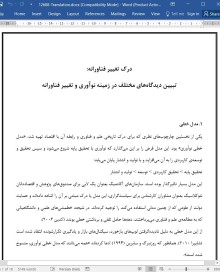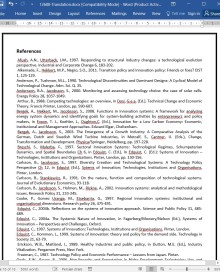
دانلود مقاله درک تغییر فناورانه: تبیین دیدگاه های مختلف در زمینه نوآوری و تغییر فناورانه
1. مدل خطی
یکی از نخستین چارچوبهای نظری که برای درک تاریخی علم و فناوری و رابطه آن با اقتصاد تهیه شد، «مدل خطی نوآوری» بود. این مدل فرض را بر این میگذارد که نوآوری با تحقیق پایه شروع میشود و سپس تحقیق و توسعهی کاربردی را به آن میافزاید و با تولید و انتشار پایان مییابد:
تحقیق پایه > تحقیق کاربردی > توسعه > تولید و انتشار
این مدل بسیار تاثیرگذار بوده است. سازمانهای آکادمیک بعنوان یک لابی برای صندوقهای پژوهش و اقتصاددانان نئوکلاسیک بعنوان مشاوران کارشناس برای سیاستگزاری، این مدل یا درک مبتنی بر آن را اشاعه دادهاند و حمایت دولت از علومی که از چنین مدلی استفاده میکند را توجیه کردهاند. در نتیجه، خطمشیهای علمی و دانشگاهیانی که به مطالعهی علم و فناوری میپرداختند، دههها حامل تلقی و برداشتی خطی بودند (کدین 2006).
از این مدل خطی به دلیل نادیدهگرفتن لوپهای بازخورد، سیگنالهای بازار و یادگیری تکرارشونده انتقاد شده است (شاپیرا 2010). همانطور که روزنبرگ و سایرین (1994) ادعا کردهاند «همه میدانند که مدل خطی نوآوری، منسوخ شده است».
2. ماهیت نظاموَند نوآوری
بنابراین دیدگاه مدرن دربارهی نوآوری، فراتر از مدل خطی میرود و بر خصیصهی پیچیدهی نوآوری تاکید میکند. مهمترین چارچوب جهت درک فرایند کامل نوآوری، چارچوب سیستم نوآوری است. این چارچوب، پیچیدگی نوآوری را بهرسمیت میشناسد و تاکید میکند که شرکتها بصورت منفک و جداافتاده نوآوری نمیکنند بلکه با سازمانهای بسیاری همکاری میکنند و به کنشهای سایر سازمانها نیز اتکا دارند. این سازمانها ممکن است سایر شرکتها، مجموعههای دولتی، انجیاُ، دانشگاهها، سازمانهای واسطه و غیره باشند. در کنار سازمانها، شرکتها نیز تحت تاثیر نهادهایی قرار دارند که میتوان آنها را قواعد بازی تعریف کرد. بطور کلی، متون پژوهشی بین نهادهای رسمی و غیررسمی تمایز قائل میشوند. نهادهای رسمی، مقررات و قوانین هستند و نهادهای غیررسمی، ارزشها، هنجارها و انتظارهای مشترک، روتینها و فریمهای شناختی مشترک هستند که بر کنشهای سازمانها تاثیر میگذارند. تعریفی رسمی از یک سیستم نوآورانه مبتنی بر تعریفی که فریمان (1987) ارائه کرده است، این است: شبکههای سازمانها و نهادها در بخشهای عمومی و خصوصی که فعالیتها و تعاملهایشان، فناوریهای جدیدی را آغاز و وارد میکنند و انتشار میدهند. یک تعریف حتی گستردهتر که ادکوئیست (1997) ارائه کرده است، این است: «تمام عوامل مهم اقتصادی، اجتماعی، سیاسی، سازمانی و نهادی که بر توسعه، اشاعه و استفاده از نوآوریها تاثیر میگذارند». ما چنین تعریف بسیار گسترده از سیستمهای نوآوری را تایید نمیکنیم زیرا شامل تقریباً همهچیز میشود. آنچه این تعریف بهروشنی نشان میدهد، این است که شرکتهای نوآور در یک محیط اجتماعی-اقتصادی بسیار گستردهتر تعبیه شدهاند که در آن، تاثیرهای سیاسی و فرهنگی بهمراه خطمشیهای اقتصادی به تعیین فروش، سمتوسو و موفقیت نسبی فعالیتهای نوآوری کمک میکنند (ادکوئیست 2004). مدل نوآوری با مدل خطی تعارض ندارد. در واقع مراحل تعریفشده در مدل خطی، واقعی و مهم هستند. با اینحال، چارچوب سیستمهای نوآوری بر این موضوع تاکید میکنند که این فازهای نوآوری تحت تاثیر یک محیط بسیار گستردهتر قرار میگیرند که در آن فرایند نوآوری رخ میدهد و به دلیل همین محیط، لوپهای بازخورد متعددی بین فازهای مختلف وجود دارد.
1. The linear model
One of the first (theoretical) frameworks developed for historically understanding science and technology and its relation to the economy has been the “linear model of innovation”. The model postulates that innovation starts with basic research, then adds applied research and development, and ends with production and diffusion:
Basic research ➞ Applied research ➞ Development ➞ (Production and) Diffusion The model has been very influential. Academic organizations as a lobby for research funds, and neoclassical economists as expert advisors to policy makers, have disseminated the model, or the understanding based thereon, widely, and have justified government support to science using such a model. As a consequence, science policies carried a linear conception of innovation for many decades, as well as academics studying science and technology (Godin, 2006).
The linear model has been criticized for ignoring feedback loops, market signals, and iterative learning, and for over-narrowly equating research and development with innovation (Shapira, 2010). As claimed by N. Rosenberg and others (1994) “everybody knows that the linear model of innovation is dead” (Rosenberg, 1994).
2. Th e systemic nature of innovation
The modern view on innovation therefore goes beyond the linear model and stresses the complex character of innovation. The most important framework to understand the complete innovation process is the innovation system framework. It recognizes the complexity of innovation and stresses that firms normally do not innovate in isolation but collaborate with many other organizations and are also dependent on the actions of other organizations. These organizations can be other firms, government bodies, NGO’s, universities, intermediary organizations and so on. Next to organizations, firms are also influenced by institutions which can be defined as the rules of the game. Generally, the literature distinguishes between formal and informal institutions. Formal institutions are regulations and laws while informal institutions are values, norms, shared expectations, routines and shared cognitive frames that influence the actions of organizations. A formal definition of an Innovation System based on the definition by Freeman (1987) is the following: the networks of organizations and institutions in the public and private sectors whose activities and interactions initiate, import and diffuse new technologies. Another even broader definition by Edquist (1997) is “all important economic, social, political, organizational, institutional factors that influence thedevelopment, diffusion and use of innovations”. We do not subscribe such a very broad definition of innovation systems since it includes almost everything. What the definition clearly shows though is that innovating firms are embedded in a much wider socio-economic environment in which political and cultural influences as well as economic policies help to determine the scale, direction and relative success of innovation activities (Edquist, 2004a,Edquist, 2004b). The innovation model is not contradictory with the linear model. In fact, the stages defined in the linear model are real and important. However, the innovation systems framework highlights that these phases in innovation are influenced by a much wider environment in which the innovation process takes place and that due to this environment many feedback loops exist between the different phases.
1. مدل خطی
2. ماهیت نظاموَند نوآوری
3. عملکرد سیستم نوآوری
4. شکستهای نظاموَند/مسائل نظاموَند
5. انواع مختلف سیستمهای نوآوری
6. مقایسه رویکرد سیستم نوآوری با سایر رویکردها
منابع
1. The linear model
2. The systemic nature of innovation
3. Innovation system functioning
4. Systemic failures / systemic problems
5. Different types of Innovation Systems
6. The comparison of the innovation system approach to other approaches
References
- اصل مقاله انگلیسی با فرمت ورد (word) با قابلیت ویرایش
- ترجمه فارسی مقاله با فرمت ورد (word) با قابلیت ویرایش، بدون آرم سایت ای ترجمه
- ترجمه فارسی مقاله با فرمت pdf، بدون آرم سایت ای ترجمه



